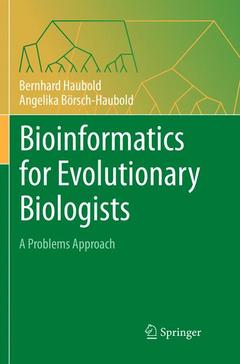Description
Bioinformatics for Evolutionary Biologists, Softcover reprint of the original 1st ed. 2017
A Problems Approach
Authors: Haubold Bernhard, Börsch-Haubold Angelika
Language: English
Subject for Bioinformatics for Evolutionary Biologists:
49.57 €
In Print (Delivery period: 15 days).
Add to cart318 p. · 15.5x23.5 cm · Paperback
Description
/li>Contents
/li>Biography
/li>Comment
/li>
This self-contained textbook covers fundamental aspects of sequence analysis in evolutionary biology, including sequence alignment, phylogeny reconstruction, and coalescent simulation. It addresses these aspects through a series of over 400 computer problems, ranging from elementary to research level, to enable learning by doing. Students solve the problems in the same computational environment used for decades in science ? the UNIX command line. This is available on all three major operating systems for PCs: Microsoft Windows, Mac-OSX, and Linux. To learn using this powerful system, students analyze sample sequence data by applying generic tools, bioinformatics software, and over 40 programs specifically written for this course. The solutions for all problems are included, making the book ideal for self-study. Problems are grouped into sections headed by an introduction and a list of new concepts and programs. By using practical computing to explore evolutionary concepts and sequence data, the book enables readers to tackle their own computational problems.
Part I UNIX.- 1 Getting Started.- 2 Files.- 3 Scripts. Part II Optimal Alignment.- 4 Sequence Evolution.-and Alignment.- 5 Amino Acid Substitution Matrices.- 6 Protein Evolution.- 7 The Number of Possible Alignments.- 8 Dot Plots.- 9 From Dot Plot to Alignment.- 10 Optimal Global Alignment.- 11 Age of the Adh/Adh-dup Gene Duplication in Drosophila.- 12 Optimal and Simplified Local Alignment.- Part III Exact Matching.- Classical Methods.- 14 Suffix Trees.- 16 Text Compression.- Part IV Fast Alignment.-17 Shotgun Sequencing.- 18 Fast Global Alignment.- 19 Fast Local Alignment.- 20 Statistics of Local Alignments.- 21 Clustering of the M. genitalium Proteome.- 22 Position-Dependent Amino Acid Score Matrix: PSI-BLAST.- 23 Optimal Multiple Sequence Alignment.- 24 Heuristic Multiple Sequence Alignment.- Part V Phylogeny.- 26 Rooted Phylogeny.- 27 Unrooted Phylogeny.- Part VI Coalescent.-28 Ancestors.- 29 The Wright-Fisher Model.- 30 The Coalescent.- 31 The Coalescent with Recombinati
on.- Part VII Answers.- ReferencesBernhard Haubold studied Natural Sciences at Cambridge University, UK and completed his DPhil in Bacterial opulation Genetics at Oxford University, UK in 1998. After training as a Post-Doc at the Max-Planck-Institute for Chemical Ecology in Jena, Germany he worked in the biotech industry before taking on a professorship in Bioinformatics at the University of Applied Sciences, Weihenstephan, Germany in 2003. In 2008, he moved to his current post as a researcher at the Max-Planck-Institute for Evolutionary Biology in Plön, Germany. He also teaches Bioinformatics at Lübeck University. Together with Thomas Wiehe he is the author of Introduction to Computational Biology, An Evolutionary Approach, which was published by Birkhäuser in 2006.
Covers fundamental aspects of sequence analysis in evolutionary biology, such as sequence alignment, phylogeny reconstruction, and coalescent simulation
Covers the material exclusively through 400 computer problems to enable learning by doing
Offers solutions to all problems to encourage self-study at a pace determined by the student
Contains over 30 programs written specifically for this book, which are provided as source code for further study
Ensures long-term usability of the course material by concentrating on fundamental concepts and utilizing the UNIX command line
Includes supplementary material: sn.pub/extras

